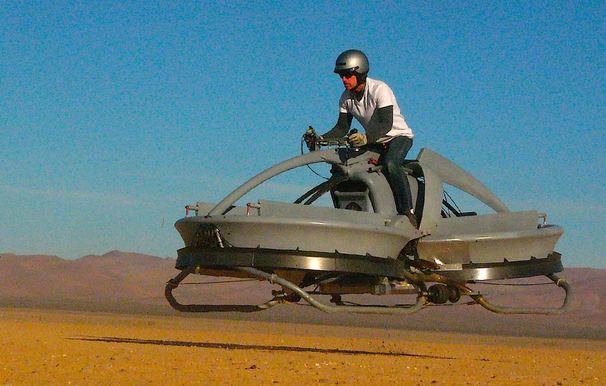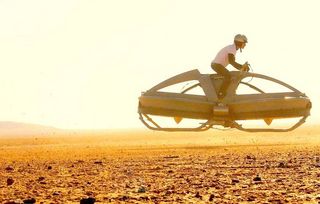New Hover Vehicle Recalls 'Star Wars' Bike

A resurrected hover vehicle won't fly through dense forests as effortlessly as the "Star Wars" speeder bikes from "Return of the Jedi," but its intuitive controls could someday allow anyone to fly it without pilot training.
The aerial vehicle resembles a science fiction flying bike with two ducted rotors instead of wheels, but originates from a design abandoned in the 1960s because of stability and rollover problems. Aerofex, a California-based firm, fixed the stability issue by creating a mechanical system — controlled by two control bars at knee-level — that allows the vehicle to respond to a human pilot's leaning movements and natural sense of balance.
"Think of it as lowering the threshold of flight, down to the domain of ATV's (all-terrain vehicles)," said Mark De Roche, an aerospace engineer and founder of Aerofex.
Such intuitive controls could allow physicians to fly future versions of the vehicle to visit rural patients in places without roads, or enable border patrol officers to go about their duties without pilot training. All of it happens mechanically without the need for electronics, let alone complicated artificial intelligence or flight software. [See Hover 'Bike' Fly (Video)]
"It essentially captures the translations between the two in three axis (pitch, roll and yaw), and activates the aerodynamic controls required to counter the movement — which lines the vehicle back up with the pilot," De Roche told InnovationNewsDaily. "Since [the pilot's] balancing movements are instinctive and constant, it plays out quite effortlessly to him."
But Aerofex does not plan to immediately develop and sell a manned version. Instead, the aerospace firm sees the aerial vehicle as a test platform for new unmanned drones — heavy-lift robotic workhorses that could use the same hover technology to work in agricultural fields, or swiftly deliver supplies to search-and-rescue teams in rough terrain.
Even the soldiers or Special Forces might use such hover drones to carry or deliver heavy supplies in the tight spaces between buildings in cities. U.S. Marines have already begun testing robotic helicopters to deliver supplies in Afghanistan.
Get the Space.com Newsletter
Breaking space news, the latest updates on rocket launches, skywatching events and more!

The hovering drones would not fly as efficiently as helicopters because of their shorter rotor blades, but their enclosed rotors have the advantage of a much smaller size and safety near humans.
"They are less efficient than a helicopter, which has the benefit of larger diameter rotors," De Roche explained. "They do have unique performance advantages, though, as they have demonstrated flight within trees, close to walls and under bridges."
Aerofex has currently limited human flight testing to a height of 15 feet and speeds of about 30 mph, but more out of caution rather than because of any technological limits. Older versions of the hover vehicles could fly about as fast as helicopters, De Roche said.
Flight testing in California's Mojave Desert led to the presentation of a technical paper regarding Aerofex's achievements at the Future Vertical Lift Conference in January 2012. The company plans to fly a second version of its vehicle in October, and also prepare an unmanned drone version for flight testing by the end of 2013.
This story was provided by InnovationNewsDaily, a sister site to SPACE.com. You can follow InnovationNewsDaily Senior Writer Jeremy Hsu on Twitter @ScienceHsu. Follow InnovationNewsDaily on Twitter @News_Innovation, or on Facebook.
Join our Space Forums to keep talking space on the latest missions, night sky and more! And if you have a news tip, correction or comment, let us know at: community@space.com.
Jeremy Hsu is science writer based in New York City whose work has appeared in Scientific American, Discovery Magazine, Backchannel, Wired.com and IEEE Spectrum, among others. He joined the Space.com and Live Science teams in 2010 as a Senior Writer and is currently the Editor-in-Chief of Indicate Media. Jeremy studied history and sociology of science at the University of Pennsylvania, and earned a master's degree in journalism from the NYU Science, Health and Environmental Reporting Program. You can find Jeremy's latest project on Twitter.












